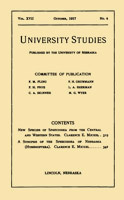University Studies of the University of Nebraska
Date of this Version
January 1888
Abstract
Whether light coming from the remotest members of the visible universe has not been enfeebled to a greater extent than the variation of distance would require, is still an open question. If there be absorption at all, it must be exceedingly small through spaces comparable with the dimensions of the solar system, in order that the light of these distant bodies may be perceived.
It is proposed in the present paper to investigate the phenomena which would occur if the energy were absorbed by the ether itself through frictional forces or imperfect elasticity. If absorption does take place, there must be a differential effect for varying wave-lengths, if the ether satisfies the equations of motion of elastic bodies. Several arguments have been advanced as proving that such an absorption takes place; of which those of Cheseaux, Olbers, and Struve are the most celebrated. Considerations on other grounds would seem to suggest such a conclusion. Cheseaux and Olbers, arguing from insufficient data as to stellar distribution, have shown that if the number of stars is infinite and distributed with anything like uniformity in space there must be absorption of light, as otherwise the sky would appear all over of a brightness approaching that of the sun, since the brightness at any point depends on the depth of the luminous layer and the solid angle which it subtends at that point.


Comments
Published in [Nebraska] University Studies 1:1 (July 1888), pp. 1-17.